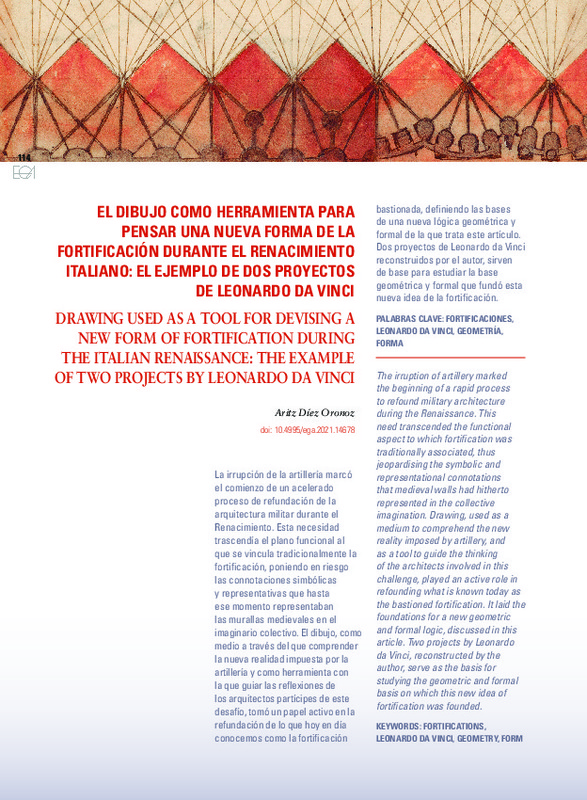JavaScript is disabled for your browser. Some features of this site may not work without it.
Buscar en RiuNet
Listar
Mi cuenta
Estadísticas
Ayuda RiuNet
Admin. UPV
Drawing used as a tool for devising a new form of fortification during the Italian Renaissance: the example of two projects by Leonardo da Vinci
Mostrar el registro sencillo del ítem
Ficheros en el ítem
| dc.contributor.author | Diez Oronoz, Aritz
|
es_ES |
| dc.date.accessioned | 2021-07-19T11:04:59Z | |
| dc.date.available | 2021-07-19T11:04:59Z | |
| dc.date.issued | 2021-07-16 | |
| dc.identifier.issn | 1133-6137 | |
| dc.identifier.uri | http://hdl.handle.net/10251/169466 | |
| dc.description.abstract | [EN] The irruption of artillery marked the beginning of a rapid process to refound military architecture during the Renaissance. This need transcended the functional aspect to which fortification was traditionally associated, thus jeopardising the symbolic and representational connotations that medieval walls had hitherto represented in the collective imagination. Drawing, used as a medium to comprehend the new reality imposed by artillery, and as a tool to guide the thinking of the architects involved in this challenge, played an active role in refounding what is known today as the bastioned fortification. It laid the foundations for a new geometric and formal logic, discussed in this article. Two projects by Leonardo da Vinci, reconstructed by the author, serve as the basis for studying the geometric and formal basis on which this new idea of fortification was founded. | es_ES |
| dc.description.abstract | [ES] La irrupción de la artillería marcó el comienzo de un acelerado proceso de refundación de la arquitectura militar durante el Renacimiento. Esta necesidad trascendía el plano funcional al que se vincula tradicionalmente la fortificación, poniendo en riesgo las connotaciones simbólicas y representativas que hasta ese momento representaban las murallas medievales en el imaginario colectivo. El dibujo, como medio por el que comprender la nueva realidad impuesta por la artillería y herramienta con la que guiar las reflexiones de los arquitectos participes de este desafío, tomó un papel activo en la refundación de lo que hoy en día conocemos como la fortificación bastionada, definiendo las bases de una nueva lógica geométrica y formal de la que trata este artículo. Dos proyectos de Leonardo da Vinci reconstruidos por el autor, sirven de base para estudiar la base geométrica y formal que fundó esta nueva idea de la fortificación. | es_ES |
| dc.language | Español | es_ES |
| dc.language | Inglés | es_ES |
| dc.publisher | Universitat Politècnica de València | es_ES |
| dc.relation.ispartof | EGA Expresión Gráfica Arquitectónica | es_ES |
| dc.rights | Reconocimiento - No comercial - Sin obra derivada (by-nc-nd) | es_ES |
| dc.subject | Fortifications | es_ES |
| dc.subject | Leonardo da Vinci | es_ES |
| dc.subject | Geometry | es_ES |
| dc.subject | Form | es_ES |
| dc.subject | Fortificaciones | es_ES |
| dc.subject | Geometría | es_ES |
| dc.subject | Forma | es_ES |
| dc.title | Drawing used as a tool for devising a new form of fortification during the Italian Renaissance: the example of two projects by Leonardo da Vinci | es_ES |
| dc.title.alternative | El dibujo como herramienta para pensar una nueva forma de la fortificación durante el Renacimiento italiano: el ejemplo de dos proyectos de Leonardo da Vinci | es_ES |
| dc.type | Artículo | es_ES |
| dc.identifier.doi | 10.4995/ega.2021.14678 | |
| dc.rights.accessRights | Abierto | es_ES |
| dc.description.bibliographicCitation | Diez Oronoz, A. (2021). Drawing used as a tool for devising a new form of fortification during the Italian Renaissance: the example of two projects by Leonardo da Vinci. EGA Expresión Gráfica Arquitectónica. 26(42):114-127. https://doi.org/10.4995/ega.2021.14678 | es_ES |
| dc.description.accrualMethod | OJS | es_ES |
| dc.relation.publisherversion | https://doi.org/10.4995/ega.2021.14678 | es_ES |
| dc.description.upvformatpinicio | 114 | es_ES |
| dc.description.upvformatpfin | 127 | es_ES |
| dc.type.version | info:eu-repo/semantics/publishedVersion | es_ES |
| dc.description.volume | 26 | es_ES |
| dc.description.issue | 42 | es_ES |
| dc.identifier.eissn | 2254-6103 | |
| dc.relation.pasarela | OJS\14678 | es_ES |








